The 3 Main Kakejiku Styles
ed: This article was originally published on the former website of Fuh-Mi (a Japanese calligrapher who mainly works in the field of contemporary art and who offers many works on our website).
In Japan, calligraphy, ink drawing (sumi-e), and painting (nihonga) are traditionally displayed on a kakejiku (also called sometimes kakemono). It's a lengthy scroll-like composition made of fabric and paper that's linked to a jiku, the central wooden pole. The word kakejiku means "Hanged jiku" in English.
There are various types (and sub-styles) of Kakejiku, each having its own layout and proportions, but we'll focus on the three most common in this article.
Kakejiku are asymmetrical, with a longer upper and shorter lower part. This is due to two reasons:
- Kakejiku are tall, but they are always viewed from a seated position, resulting in a skewed perspective. A longer top section corrects this and balances the composition.
- A longer top section provides greater protection (more layers) when rolling up the calligraphy to put it in its kiri box.
Yamato Hyoso Style
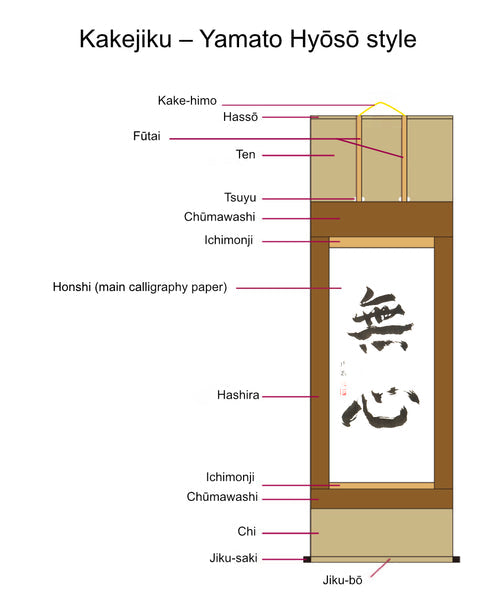
Yamato Hyoso Style
Also known as sandan hyōsō, or "3-story style." This is perhaps the most common kakejiku layout. The calligraphy (honshi - 本紙) is framed by two distinct fabrics that have been layered in three sections.
The two pillars (hashira - 柱) at the left and right of the calligraphy, as well as the chūmawashi (中廻し) at the top and bottom, make up the central part. The fabric used to make hashira and chūmawashi is the same. The calligraphy is further embellished with two ichimonji (一文字) accent lines, which are usually made of golden brocade.
The top and bottom parts, known as ten (天) and chi (地), respectively, "heaven and earth," are made of a different colour fabric than the middle section.
The jiku (軸) wooden pole is at the bottom, around which the calligraphy is rolled up when put in storage. The jiku-saki (軸先) serve as a decorative element as well as handles for rolling up the scroll. On the opposite side, there is a half-moon-shaped pole called hassō (八双), which is connected to the hanging cord (kake-himo - 掛け紐) and is used to "seal" the scroll rolled up.
Finally, on the upper section, there are two decorative vertical lines known as fūtai (風帯). They're usually made of the same material as ichimonji. Their bottom tip is sometimes shaped like a fan, which is known as tsuyu (露). The fūtai are a relic of an ancient Chinese tradition where calligraphies and paintings were displayed outside, and two pieces of fabric were left to flutter in the wind, acting as a scarecrow to keep swallows away from the kakejiku. The word fūtai means "wind belts" in English.
Maru Hyoso Style

Maru Style
The Maru style is a simplified version of the Yamato style, with a unique fabric used for the middle part, ten and chi.
It is less formal than the Yamato version and can be thus displayed in a variety of settings. Yamato style is usually reserved for smaller artworks, whereas Maru style is favored for lengthier and larger compositions.
Butsu Hyoso Style
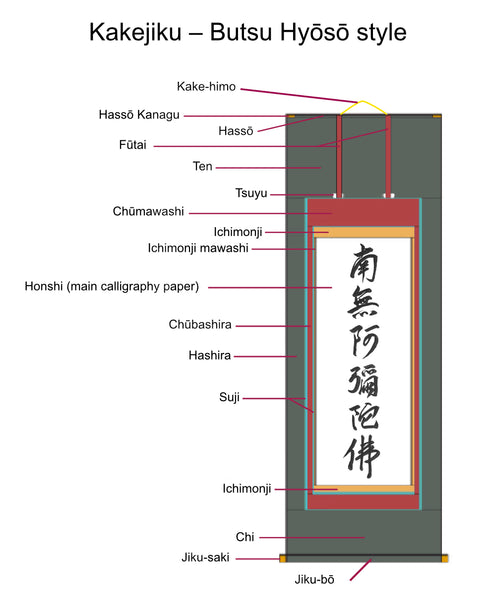
Butsu Style
Finally, the Butsu style is a unique arrangement reserved for Buddhist works such as paintings of Kannon or legendary Bodhisattvas, prayer calligraphies, and so on. It includes elements of both the Yamato and Maru styles, and typically employs highly adorned fabric in golden tones.
In the Butsu style, ichimonji and ichimonji mawashi (一文字廻し), then chūmawashi (中廻し) and chūbashira (中柱) are two extra layers of frame surrounding the calligraphy. Suji (筋), or accent lines, are used to distinguish each layer.
The Butsu style fūtai, unlike the Yamato style, are made from the same cloth as the chūmawashi. The top hassō pole can be decorated with metallic parts called hassō-kanagu (八双金具), which match the design and colour of the jiku-saki (usually gold).
To conclude
Kakejiku is a rich, centuries-old Japanese tradition that originated in China and has evolved over time. Each main style contains at least three sub-styles with minute variations, to the point where even Japanese people are frequently confused as to which is which. Furthermore, many contemporary artists now use non-traditional kakejiku, incorporating new styles and modern materials. Kakejiku is a dynamic culture that continues to evolve alongside Japanese society.

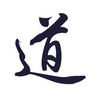
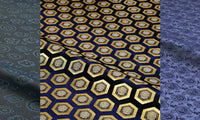
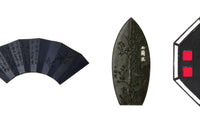

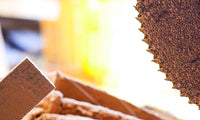
2 comments - The 3 Main Kakejiku Styles
Hello Edward,
As said in the article, the two Futai are relics of an ancient Chinese tradition and act as scarecrows as calligraphies were initially displayed outside. They are made of the same material as the ichimonji and connected to the Hasso.
Hope it answers your questions.
For the Yamato Hyoso style please could you tell me about the two futai. Why are they there? What are they made of? And are they attached to the ten?
I thank you sincerely – Edward, Toronto, Canada.